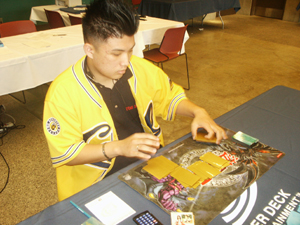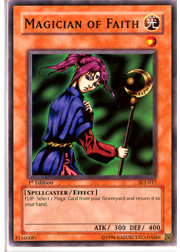
It’s no secret that this format has been swamped with Chaos/Return variants and Cyber-Stein-based OTKs. While many decks look somewhat different, they all end up relying on the power of Chaos Sorcerer. Come September 1st however, this will all change. The banning of Chaos Sorcerer, Tsukuyomi, and Snatch Steal means that there is even less reason now to play a general deck than ever before. That trio of power cards often tore original decks apart. Now that decks no longer have to fear the power of Chaos Sorcerer or the impending Tsukuyomi engine, there is more room for combos and new ideas.
This is sure to be an exciting format. As both a player and a writer, I look forward to attempting to crack the format and/or reporting on whoever can do it first. I expect that most players will revert to decks already in circulation. It’s a solid idea. They don’t lose much power, but they lose a bad matchup. Warrior Toolbox, Zombies, Fiends and different control variants all have a new hope at becoming the next best deck.
For those who are trying to tie this in to Jae Kim, the Champion for this week, you’re likely still unsure of which deck I’m going to feature. This fact alone speaks to Jae’s credentials. Most players featured in this article haven’t pioneered more than one original deck. Jae, on the other hand, has two Shonen Jump Championship Top 8 performances with very unique ideas. At SJC Charlotte, he flattened round after round of straight Goat Control decks to take 2nd place with a unique Zombie build. While the deck was solid, most players noted its ability use three Book of Moon cards and three Dust Tornado cards. When combined, they almost completely nullified the Scapegoat/Metamorphosis threat. It was a tremendous breakthrough in Yu-Gi-Oh! TCG strategy and made Jae justifiably famous.
The deck I will be featuring this week, however, is Jae’s SJC Seattle list. Taking a look at the other deck lists, we see that Goat Control was at its peak here. Abusing Tsukuyomi and Magician of Faith with power cards such as Delinquent Duo and Pot of Greed was all the rage. While many players saw the potential to crack the format, very few made the bold move towards doing it. The fear of a first turn Delinquent Duo and a second turn Magician of Faith was too great. While Warrior Toolbox was definitely an acknowledged archetype at the time, no one considered its status at tier 1 a possibility. That is, until Jae stormed his way to a Top 4 finish with this deck list:
Monsters: 16
2 D. D. Assailant
1 D. D. Warrior Lady
1 Blade Knight
1 D.D. Survivor
1 Black Luster Soldier - Envoy of the Beginning
1 Sangan
1 Sinister Serpent
1 Airknight Parshath
1 Morphing Jar
1 Breaker the Magical Warrior
2 Magician of Faith
1 Exiled Force
1 Big Shield Gardna
1 Don Zaloog
Spells: 16
1 Pot of Greed
1 Graceful Charity
1 Delinquent Duo
1 Premature Burial
1 Snatch Steal
2 Nobleman of Crossout
1 Mystical Space Typhoon
1 Heavy Storm
1 Reinforcement of the Army
1 Lightning Vortex
2 Smashing Ground
2 Book of Moon
1 My Body as a Shield
Traps: 8
2 Dust Tornado
1 Call of the Haunted
1 Mirror Force
1 Ring of Destruction
1 Mirror Wall
1 Torrential Tribute
1 Robbin’ Goblin
 Jae’s Warrior Toolbox was oozing with synergy, tech, and nasty new combos. We again see Jae playing the Dust Tornado/Book of Moon combo, though only at two cards apiece. The toolbox deck was designed to be the perfect counter to a slow-playing metagame. The deck is fast, especially for a Goat Control metagame, and it packs a lot of trouble on both the opponent’s turn and yours. The damage all came from your own turn and the ability to cycle cards with Tsukuyomi and friends.
Jae’s Warrior Toolbox was oozing with synergy, tech, and nasty new combos. We again see Jae playing the Dust Tornado/Book of Moon combo, though only at two cards apiece. The toolbox deck was designed to be the perfect counter to a slow-playing metagame. The deck is fast, especially for a Goat Control metagame, and it packs a lot of trouble on both the opponent’s turn and yours. The damage all came from your own turn and the ability to cycle cards with Tsukuyomi and friends.
Blade Knight and D.D. Survivor were relatively unheard of monsters at the time, but both had the ability to instantly negate the effects of an opponent’s monster. Since their threat was never really in the format, many players abused the power of cards like D. D. Assailant and D. D. Warrior Lady, as well as many flip effect monsters. There were also very few defensive cards. Protecting monsters was never really necessary, and Sheep protected your life points. There was enough monster removal, so why pack in more when it wasn’t needed? This was exactly the mentality that Jae’s toolbox thrived on, and drawing a copy of either Survivor, Blade Knight or Reinforcement of the Army meant opposing monsters were taken down without getting their effects off.
The remainder of the toolbox consisted of Exiled Force, Big Shield Gardna, Don Zaloog, Jae’s own set of D. D. Assailant cards and a copy of D. D. Warrior Lady. The D.D. monsters and Exiled Force combined for a healthy dose of monster removal, and helped ensure that any monster on the field could be neutralized. Big Shield Gardna meant that Jae could protect flip effects by baiting out Crossouts or simply scaring the opponent into not playing Nobleman of Crossout. Gardna also offered an unheard of defense, which usually required an over-commitment to the field to take out. Don Zaloog took advantage of any slip-up on the opponent’s part, and pierced through a defenseless field to take cards out of the opponent’s hand and force them into action. With multiple copies of Dust Tornado in the deck, Don Zaloog was a huge card for Jae.
 The rest of the deck’s monster line-up was consistent with the times. A pair of Magician of Faith cards helped Jae abuse the trinity as often as possible, while Black Luster Soldier - Envoy of the Beginning was the finisher. Airknight Parshath simply tore through Sheep, and was definitely a power card at the time. Breaker the Magical Warrior, Sangan, and Sinister Serpent don’t require much explanation, and Morphing Jar was a staple because of its ability to stabilize against the opponent’s best hands.
The rest of the deck’s monster line-up was consistent with the times. A pair of Magician of Faith cards helped Jae abuse the trinity as often as possible, while Black Luster Soldier - Envoy of the Beginning was the finisher. Airknight Parshath simply tore through Sheep, and was definitely a power card at the time. Breaker the Magical Warrior, Sangan, and Sinister Serpent don’t require much explanation, and Morphing Jar was a staple because of its ability to stabilize against the opponent’s best hands.
Jae’s spell and trap line-ups are quite interesting. Here we see the birth of a lot of tech that’s been used since. Robbin’ Goblin has gained some popularity as of late, though for different reasons. Jae used it here to force the opponent to play aggressively and commit more to the field than he or she should. Goat Control was unfamiliar with the strategy, and usually unable to handle it. Jae avoided overextending his own spell and trap zone through Dust Tornado. By setting Robbin’ Goblin off of Dust Tornado, he got the use out of Robbin’ Goblin he desired without having to commit to the fact that it’s a continuous trap card. When used in conjunction with Airknight Parshath or Don Zaloog, Robbin’ Goblin could get nasty.
Another card with amazing synergy in this deck is Mirror Wall. One obvious problem with Warriors is their general lack of high attack values: they can be taken down quickly by Airknight Parshath or D.D. monsters. Mirror Wall would often act as a Sakuretsu Armor, destroying opposing monsters and causing minimal damage to boot. However, when used with Jae’s Airknight Parshath, Don Zaloog, or Robbin’ Goblin, Mirror Wall became a nasty engine for forcing more cards out of the opponent’s hand or into his. This type of card manipulation during battle was hard to cope with for the Goat Control player.
Jae had the usual spells and traps for the era. There were many power cards, and even original decks had to utilize them. Though we’re certainly used to seeing Smashing Ground in many Top 8 deck lists today, it was a much less popular card at the time. Jae used it to remove opposing Thousand-Eyes Restrict cards, Airknight Parshath cards, or Black Luster Soldier cards from the field. Anything that Jae couldn’t take out cleanly with a tool from Reinforcement of the Army was met with Smashing Ground. He had to keep play moving fast, and this was the perfect card.
Players have long had a love-hate relationship with My Body as a Shield. The ability to negate power cards with quick-play magic cannot be overstated, but it comes with a hefty life point price. Jae ran one copy in this deck, which is perfect. Drawing too many can mean trouble against an opposing swarm of monsters. Drawing a copy isn’t necessary, but when drawn, Jae can force the opponent into thinking he’s walked into Torrential Tribute or Mirror Force and surprise them with My Body as a Shield. Being able to negate destruction effects on Jae’s turn meant that his Warriors got to slice up effect monsters that much more.
Jae started the Warrior Toolbox craze quite some time ago, but it didn’t really come to fruition until the last format, prior to the rise of Flip Flop Control and Bazoo/Return. Just like the previous format, expect Warrior Toolbox to be one of the faster horses out of the gates this September.